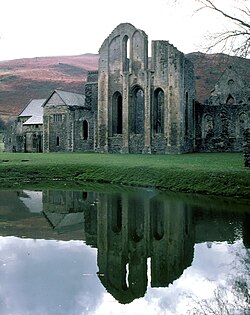Valle Crucis Abbey
| Valle Crucis Cistercian Abbey | |
|---|---|
 Valle Crucis Cistercian Abbey |
|
| location |
|
| Coordinates: | 52 ° 59 ′ 22 ″ N , 3 ° 11 ′ 0 ″ W |
| Serial number according to Janauschek |
530 |
| founding year | 1201 |
| Year of dissolution / annulment |
1537 |
| Mother monastery | Strata Marcella Abbey |
| Primary Abbey | Clairvaux Monastery |
|
Daughter monasteries |
no |
Valle Crucis Abbey (Llanegwast) is a former Cistercian abbey about 2½ km north-north-west of Llangollen on the A 542 road to Ruthin in Denbighshire (formerly Clwyd ) in Wales .
history
The abbey was a subsidiary of Strata Marcella Abbey from the filiation of Clairvaux Primary Abbey . The construction of Valle Crucis began around 1201. Prince Madog ap Gruffydd Maelor and his son Gruffydd Maelor ap Madog generously furnished the young abbey; both were buried here in 1236 and 1270 respectively. On the lower masonry of the church and in the southern monastery area, traces of a fire from the time after the founder's death can be found. The subsequent reconstruction was already well advanced when the abbey suddenly found itself on the losing side during the Welsh campaigns of Edward I in 1276/77 and 1282/83 . However, the compensation granted later secured the abbey’s existence into the next century. After the plague hit Wales, the number of monks decreased. During the 15th century the abbey's wealth surely increased, for the hospitality of its abbots was widely celebrated; on the other hand, there were only a few brothers left.
In 1537, Valle Crucis was dissolved as one of the smaller houses, although its prosperity was certainly not comparable to that of many English abbeys. Things of value gradually migrated to the surrounding village churches, and the complex was left to its own devices. One house was inhabited again in the late 16th century, and some houses were re-roofed and used as a farm in the 18th century. Additional destruction finally set in in the 19th century when the buildings served as a quarry for the population.
In the middle to the end of the 19th century, the first excavations and work to preserve the ruins were carried out. The dormitory houses a fine collection of medieval sculptures, and there is a small exhibit that brings the monastic life of the Cistercians of Valle Crucis to life.
The popular name "Cross Valley" probably goes back to one of the famous high crosses in Wales, Eliseg's Pillar, which measures almost three meters and is still in its place near the abbey. The Latin inscription of the cross is from the 9th century and says that it was built by Cyngen for his ancestor Eliseg; Cyngen died around 854 on a pilgrimage to Rome. Eliseg was apparently also taken as the namesake for the surrounding Eglwyseg Mountains and Eglwyseg Rocks; he is said to have freed the state of Powys from the Saxons.
Buildings and plant
Today only the ruins of the monastery church and some outbuildings can be seen. The church is in the north of the complex. It had a three-aisled nave with five bays of modest dimensions, a transept from the early (north transept) and late (south transept) 13th century with two side chapels in the east and a rectangular choir with three lancet windows and above two preserved (and one lost) further windows. The cloister is to the south (right) of the church; the four-column chapter house was renovated in the 14th century. Above is the dormitory, the roof of which has been renewed.
literature
- Anthony New: A guide to the Abbeys of England and Wales. Constable & Company, London 1985, ISBN 0-09-463520-X , pp. 400-403, with a plan.






